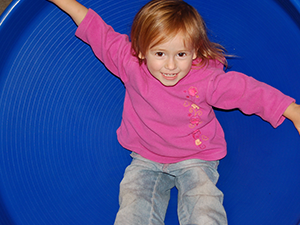Sensory Play – Toddler
 Sensory play – exploring the body’s senses of sight, sound, touch, taste, smell, balance and movement, is vital for your toddler’s development.
Sensory play – exploring the body’s senses of sight, sound, touch, taste, smell, balance and movement, is vital for your toddler’s development.
When your toddler is engrossed in repeating the same activity over and over again there is usually a very good reason. They are actually making important brain connections and mastering a new skill. Slow down and let them practise and learn from the experience!
Did you know?
The sense of movement is important for developing balance and coordination. It can also be calming for some children (like the slow rocking of a hammock).
Add language
Different kinds of sensory play open up opportunities for learning new words that match experiences. You could say:
- “round and round” or “up and down” to match words to movement sensations
- “noisy motorbike” or “I can hear a truck” or “quiet voices” to match words to what can be heard
- “soft kitty”, “squelchy mud”, “smooth tiles”, “rough carpet” etc. to match words to how things feel to touch
Using describing words with naming words helps to build the length of your child’s sentences.
Other development
Swinging, bouncing and spinning are not only fun but develop your toddler’s sense of movement and balance.
Sensory play doesn’t always need to be messy or big. Puzzles that make sounds when you correctly put in the pieces will provide extra motivation for your toddler. It can motivate your toddler to keep trying with tricky pieces, while also developing their fine motor and visual skills. Scratch and sniff books, and books with interesting textures can help engage your toddler in the joy of book sharing.
Variations
Regularly provide a wide range of sensory experiences e.g. finger painting, playing in sand or mud, or experiencing different sounds and smells! Encourage your toddler to give new things a go. Try not to push them into doing something they don’t enjoy but show them it can be fun!
Some children have difficulty taking in and responding to information from their senses. For some children, a little bit of sensory stimulation feels like a LOT and they can get overwhelmed. For some children a lot of sensory stimulation feels very little and they take a long time to respond.
Watching your toddler and their reaction to sensory stimulation (sights, smells, tastes, sounds, touch, movement) helps you get to know them better. This helps you to know what level of input they need to get them involved and what level to stop at before they get overwhelmed. Some of your toddler’s tantrums can just be that their sensory system is overloaded.
All toddlers need some regular quiet times of stillness and silence without overt sensory stimulation – quiet, slow breathing, listening to the silence. Just being peaceful and still.
Across the ages
All the activities listed on our “Play Ideas” page can be applied across different age groups. See how Sensory Play can be fun for babies, children and playgroups.
Activities listed under “toddler” are suitable for children aged 1-3 years. toddlers enjoy activities that include exploring their environment and finding out how things work.

